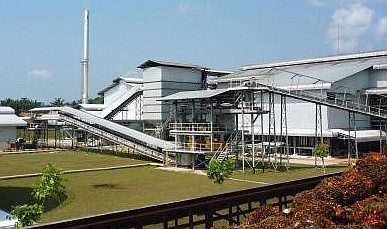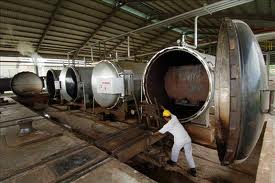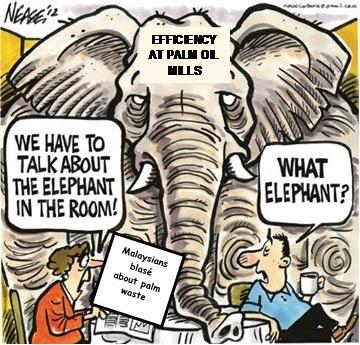Biomass Residue and Renewable Energy, Resource Efficiency at Palm Oil Mills
 Apart from palm oil, biomass residue and the renewable energy derived therefrom are among two important products, sometimes overlooked, of palm oil mills in the oil palm industry. It is imperative that palm oil mills are recognised in the context of national resource efficiency for efficient utilisation of these products in order to maximise their contribution to the industry and national economy.
Apart from palm oil, biomass residue and the renewable energy derived therefrom are among two important products, sometimes overlooked, of palm oil mills in the oil palm industry. It is imperative that palm oil mills are recognised in the context of national resource efficiency for efficient utilisation of these products in order to maximise their contribution to the industry and national economy.
Despite the energy-efficient cogeneration technology currently employed at palm oil mills, most of the prime biomass residues at palm oil mills is presently consumed merely to provide heat and power to its processes. A truly energy-efficient design of a palm oil mill incorporating readily available innovative technologies can reduce its biomass residue consumption to less than half of the present consumption. The biomass thusly saved could be utilised elsewhere for useful purposes. In addition to large quantities of surplus prime biomass conserved at the mill for export, surplus electricity can be more efficiently generated within the mill for export to the grid, where grid access is available.
The oil palm industry is one of the pillars of the Malaysian economy and is projected to generate Ringgit 178 billion revenue by 2020 through higher productivity. Strong growth in the industry plays a crucial role in the country’s economic growth. However, land, water and fertiliser use in the oil palm industry impact on the environment across the entire value chain, ranging from the release of greenhouse gases and inputs of pollutants into the air, water and soil to adverse effects on ecosystems and biodiversity. Resource efficiency at the palm oil mills therefore represents a critical opportunity to mitigate this unsustainable path, by promoting green growth of the industry whereby economic growth is decoupled from environmental harm.
‘National resource efficiency’ may be interpreted broadly, to cover efficient use of raw materials, energy sources, biomass, waste, land and soil, water and biodiversity. These are also natural resources and they are generally finite. The notion of national resource efficiency may also be applied to man-made (developed or acquired or cultivated) resources when they significantly affect national economy and the environment. The later include workforce, industrial units, agricultural units and national infrastructures. These resources too generally have constraints and therefore attention is focused on its efficient use. ‘Resources’ are crucial to the wellbeing of any country and the world has come to realise that if we ignore to use these resources efficiently, we would not be able to maintain competitiveness and sustainable industrial growth and in fact, will be doing so at our peril.
While the above are pertinent to the national resources of Malaysia, there is one important national resource that appears to have been overlooked, namely, Palm Oil Mills, in so far as their efficient usage of biomass residue and energy is concerned. The present designs of palm oil mills are energy inefficient that they consume an excessive amount of biomass energy to carry out their processes. Biomass energy usage can potentially be reduced by up to 50%.
Economic and Environmental Impacts of Energy-Efficient Palm Oil Mills
The Malaysian oil palm industry has grown by leaps and bounds to become a global leader, presently covering about 5.23 million hectares in the country. It must be pointed out that the potential surplus biomass residue or the renewable energy released industry-wide from energy-efficient palm oil mills has the potential to reduce national fossil fuel utilisation to a value by up to Ringgit 25 billion a year, a substantial amount considering Malaysia’s development expenditure budget is Ringgit 45 billion a year. The concomitant potential for national carbon reduction via the use of renewable energy is a whopping 50 million tonnes of CO2 equivalent per year. In the light of these huge economic and environmental benefits, it makes economic and environmental sense for palm oil millers and the government to relook at palm oil mills from the viewpoint of their energy utilisation within the context of national resource efficiency.
 As for the energy content in biomass residues at a palm oil mill, the following figure represents heat content in a typical 60 tonnes/hour processing capacity during its operation:
As for the energy content in biomass residues at a palm oil mill, the following figure represents heat content in a typical 60 tonnes/hour processing capacity during its operation:
| 1. | Mesocarp fibre* | 26 MW |
| 2. | Palm kernel shell* | 18 MW |
| 3. | Biogas | 6 MW |
| 4. | EFB | 14 MW |
| Total | 64 MW |
* Prime biomass
Of the above, on average, current processes in a run-of-the-mill designed palm oil extraction mill consume about 42 MW of energy from the prime biomass for heating and powering itself. In comparison, an energy-efficient palm oil mill with the right technologies could drastically reduce the consumption of prime biomass, which comprises mesocarp fibre and palm kernel shells that are presently used to provide energy for mill operations. As a result the surplus biomass or energy thus saved in the palm oil mill could displace fossil fuel used elsewhere up to a value of RM 50 million per year per mill.
National Resource Efficiency from Climate Change Perspective
 Day by day the topic of renewable energy is getting more and more attention and publicity as it is increasingly being seen as an ‘antidote’ to pressing issues tied to global warming, climate change and sustainable development. Like it or not, climate change is changing our economy, health and communities in diverse way and scientists warn that if we do not aggressively curb climate change now, the results will likely be disastrous.
Day by day the topic of renewable energy is getting more and more attention and publicity as it is increasingly being seen as an ‘antidote’ to pressing issues tied to global warming, climate change and sustainable development. Like it or not, climate change is changing our economy, health and communities in diverse way and scientists warn that if we do not aggressively curb climate change now, the results will likely be disastrous.
We, in Malaysia, are gifted in a sense – to play a starring role in this seemingly bleak scenario. As one of the world’s largest producers of palm oil, we are fortunate to be in an enviable position to harness enormous amount of renewable energy from the palm-based biomass residue at the hundreds of palm oil mills. However, we are yet to reap the full benefits, the renewable energy source currently being utilised in grossly energy-inefficient ways in the palm oil mills. But this is just status quo.
Fast forward to 2014. Innovative thinking and innovative engineering have opened up a whole new way of looking at palm oil mills rather than as merely efficient oil extraction plants. Palm oil mills hold vast potential to provide abundant surplus renewable energy when the mills are designed to be energy-efficient. Malaysia can proudly fulfil its commitment towards abating global warming and climate change by not just showing the world that it is harnessing the renewable energy in its abundant biomass but more importantly, showing the world that it has found a way to do it more efficiently than anyone has ever done before!
Carbon Footprint of Palm Oil Production
 The savings in carbon emissions by efficient use of energy at the palm oil mills have the potential to offset the carbon emissions in the palm oil supply chain. From climate change perspective, palm oil production is often blamed for its high greenhouse gas emissions with the attendant adverse spin off of intensifying global warming. The solution to rein in the carbon emissions lies at energy-efficient palm oil mills. The abundant biomass by-product remaining after extracting the palm oil presents this unique opportunity to fight global warming – both as a fuel source and inherent carbon emissions offset potential. It contains a massive amount of clean energy. When this clean energy is utilised efficiently and productively, it can offset carbon emissions at plantations and bring down the carbon footprint of palm oil production to significant low levels.
The savings in carbon emissions by efficient use of energy at the palm oil mills have the potential to offset the carbon emissions in the palm oil supply chain. From climate change perspective, palm oil production is often blamed for its high greenhouse gas emissions with the attendant adverse spin off of intensifying global warming. The solution to rein in the carbon emissions lies at energy-efficient palm oil mills. The abundant biomass by-product remaining after extracting the palm oil presents this unique opportunity to fight global warming – both as a fuel source and inherent carbon emissions offset potential. It contains a massive amount of clean energy. When this clean energy is utilised efficiently and productively, it can offset carbon emissions at plantations and bring down the carbon footprint of palm oil production to significant low levels.
Government Initiatives within the context of National Resource Efficiency
For the uninitiated, a brief history of government intervention in the palm oil industry is appropriate. The oil palm industry has always been under the purview of the government in the context of national resource efficiency, more so since the implementation of the Economic Transformation Plan (ETP) where certain targets have been set.
For example, as earmarked in Entry Point Project (EPP 4), the government has identified increasing the oil extraction rate from the palm oil fruits as priority for the national resource efficiency policy. In order to bring awareness to fruit quality among small holders, the government as a priority intervention provides advisory and enforcement services to monitor and control unripe fruit bunches arriving at the private palm oil mills. The Malaysian Palm Oil Board (MPOB) has set a tolerance rate for unripe fruit of 2-3 percent at the palm oil mills. Another example of government intervention in the private enterprise is the MYBiomass initiative for field biomass by Malaysian Industry-Government Group for High Technology (MIGHT).
From the above, it would appear that the government is on the right track and it is certainly commendable that the government has indeed gone to great lengths to study the industry in-depth to broaden and deepen the palm oil industry. But ‘so near and yet so far away…’ seems to summarise the government’s efforts to look more keenly at the Oil Palm Industry that should be treated vigilantly like all other national resources – i.e. with serious attention paid to conservation and efficient use via innovative technologies.
While the government has come so close to the industry to identify and rectify inefficiencies, it is unfortunate that the energy utilisation and biomass utilisation at palm oil mills have slipped the attention of policy makers in the context of national resource efficiency, specifically from the viewpoint for energy utilisation. This is like the proverbial ‘missing the elephant in the room’. Up to now attention seems to be focused on selected upstream activities, for example, accelerating the replanting and new planting of oil palm, improving fresh fruit bunch yield, improving worker productivity and increasing the oil extraction rate.
It’s not like the government has neglected energy efficiency all this while. The National Energy Policy of 1979 was drafted to keep with the times and included efficient utilization of energy and discouraged wasteful and non-productive patterns of energy consumption with an objective to ensure that environmental protection is not neglected in the pursuit of economic growth. However, in terms of implementation and results, it would appear that the objectives did not do well.
 There may be a few reasons why the topic of energy utilisation efficiency has not quite grabbed the attention of policy makers.
There may be a few reasons why the topic of energy utilisation efficiency has not quite grabbed the attention of policy makers.
Firstly, it could be due to unawareness that the industry has been taken over by times. Today new technologies have become available which make it possible to raise the efficiency significantly with a bonus of financial improvements to the bottom line.
Secondly, it could be the in-situ continuous nature of consumption of the mesocarp fibre and palm kernel shell residues as part of the mill process for providing energy to the mill operation. It may be perceived that the bulk of the mesocarp fibre and palm kernel shell residues in the mill is still required in the present quantities for powering the mills. In actual fact, an energy efficient mill requires only about 40% of these residues to provide energy for itself, whereby the balance can be made available for use elsewhere.
Thirdly, with today’s available technologies, biogas produced from POME can be used more efficient in an energy-efficient mill as compared to in gas engines.
Government Intervention Required
 Yes, indeed the time has come to take a closer look at the efficiency of energy utilisation from palm mesocarp fibre and palm kernel shells at palm oil mills. As a fast developing nation, we have an obligation to use our resources intelligently, and this relates to innovativeness, sustainability and responsibility, all of which will be vital for future success.
Yes, indeed the time has come to take a closer look at the efficiency of energy utilisation from palm mesocarp fibre and palm kernel shells at palm oil mills. As a fast developing nation, we have an obligation to use our resources intelligently, and this relates to innovativeness, sustainability and responsibility, all of which will be vital for future success.
The technologies required for design of energy-efficient palm oil mills are readily and immediately deployable. They represent low-cost and stage-wise implementation in existing palm oil mills. Results can be achieved in as little time as 12 months. In comparison, 5-6 years is expected for the development and uncertainty of breakthrough for technologies pursued by the MYBiomass initiative for the plantation field biomass.
Interestingly, it turns out there are a couple of important points to be considered by the government:-
- Energy potential of palm mesocarp fibre and palm kernel shells. The potential of these residues need to be recognised, from a fuel-source / energy fuel potential point of view; and
- Energy utilisation efficiency of current processes in a run-of-the-mill palm oil mill. The potential for a vast increase in energy utilisation efficiency of the mills also need to be recognised.
Surprisingly, the above was envisaged in the 8th Malaysia Plan 2001 and a noble attempt to achieve the above objectives culminated in the Biogen project. Although well-intentioned, sadly the project’s terms of reference were never realised.
National Renewable Energy Policy and Action Plan
 Industrywide, currently run-of-the-mill designed palm oil extraction mills in Malaysia consume, in total, about 10,000 MW of renewable energy from the biomass residue. The forthcoming revision of the policy and action plan should therefore take cognisance of the renewable energy consumption, enormous certainly but at present utilised at extremely low efficiencies at the palm oil mills. Efficiency of renewable energy resource utilisation should feature just as prominently as quantities consumed in the new Policy and Plan to promote and intensify the renewable energy initiative of the government.
Industrywide, currently run-of-the-mill designed palm oil extraction mills in Malaysia consume, in total, about 10,000 MW of renewable energy from the biomass residue. The forthcoming revision of the policy and action plan should therefore take cognisance of the renewable energy consumption, enormous certainly but at present utilised at extremely low efficiencies at the palm oil mills. Efficiency of renewable energy resource utilisation should feature just as prominently as quantities consumed in the new Policy and Plan to promote and intensify the renewable energy initiative of the government.
Energy-efficient palm oil mills provide multiple benefits:
- Provide an alternative for and savings of depleting fossil fuel resources,
- Reduce national carbon emissions,
- Lower carbon footprint of palm oil and derivatives (equivalent to 2nd generation biofuels),
- Increase demand for knowledge workers,
- Provide an impetus for local technology development,
- Mitigate international pressure for palm oil sustainability,
- Comply with national energy efficiency agenda; green growth agenda,
Palm oil mills are too important a national resource for government to not intervene in order to ensure efficiency of energy usage.
Improving something that’s not valued in the market … requires more investment.
A lighter laptop, or one with a longer battery life, provides an obvious benefit to the consumer,
whereas a consumer wouldn’t notice when using new energy technologies whether there’s more or less carbon emissions.
That’s where government regulations and investments can help jump-start new technology, says a professor at MIT.
Empty Fruit Bunches
The subject matter of this article would not be complete without mention of Empty Fruit Bunches (EFB) which is commonly popular as an energy source. EFB is presently used as an energy source away from the palm oil mill in isolated stand-alone electricity producing plants and qualify for Feed-in-Tariff.
Biomass energy is a double-edged sword, depending on how and where it is produced. It can be produced in ways that reduce global warming pollution or in ways that increase it.
The challenge today is to ensure that biomass energy is produced in ways that not only reduce global warming pollution, but also protect the environment and do not increase the price of food. In other words, biomass energy should do the job better than the fossil fuels it replaces.
In producing biomass energy from EFB burning plants, the long haul transportation required for the EFB, the removal of vast amount of moisture that EFB contains and the technology presently employed in stand-alone power producing plants need to be looked into for net carbon reduction.
In comparison, in-situ energy generation and utilisation in the palm oil mill using cogeneration or combined heat and power (CHP) technology has many times more potential for net carbon reduction and therefore energy efficiency of this process should be critically encouraged. Cogeneration technology allows the residual heat from a power producing plant to be extracted as usable heat for useful process heating.
Synopsis
This article is not intended to expound the fact that the Oil Palm Industry has critical mass in terms of volume of biomass but rather not enough attention has been paid to its efficiency of usage – at the palm oil mills. What we propose is radical and revolutionary… – not just promoting the use of renewable energy but improving the efficiency of utilisation of biomass as an energy or fuel source at palm oil mills. Wellbeing can be realised for both the environment and the company in sale of biomass and electricity.
Our contention is that efficiency of biomass energy utilisation has not been given the prominence it deserves rightly under the country’s energy policies – owing primarily to technological constraints in the past.
There is a genie trapped in a bottle, waiting to be unleashed. All it needs is the right emphasis and technologies … and government will.
Pollution is nothing but the resources we are not harvesting. We allow them to disperse because we’ve been ignorant of their value.


2 replies on “Palm Oil Mills, in the Perspective of National Resource Efficiency”
That is interesting. Harness waste to good health and greater wealth.
Good article.. policy maker, markets and mill owners need high level of cooperation and commitment for it. Thanks.